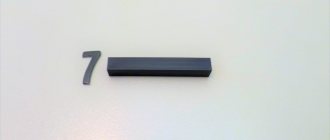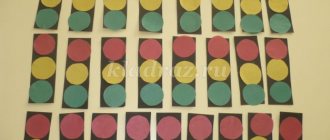Games with Cuisenaire sticks for children from 5 to 9 years old
For older children, such aids as:
- A set of games “On the Golden Porch” for children from 3 to 9 years old.
- Set of games “China shop. Krostiki" for children from 5 to 8 years old.
With the help of these kits, children will easily get acquainted with the principle of coloring sticks, with the relationships of color - length - number; will be able to recognize a pattern and lay out sticks in accordance with it; will be able to lay out (reproduce) an object along its contour, master the operations of “decoding” images; get acquainted with symmetry; learn to navigate on a plane and work with a coordinate system.
- Once upon a time there were colorful sticks. They were in a tight box. And then one day, when all the sticks were poured out of the box, they decided to build themselves colorful houses and live there as families.
- Anya, let's cast a spell on the little kitten and put it out of sticks.
Interesting cards are cards with tasks that allow you to independently lay out an image according to a diagram.
Tasks of increased complexity include cards with image content encoded in numbers. The young player needs to “decode” this image and build it using sticks.
An excellent tool is the mathematical game “China Shop. Krostiki" for children from 5 to 8 years old. In this manual, children are offered tasks to design in a coordinate system. At first, completing tasks of this level of complexity was too much for even my eldest 8-year-old daughter Masha.
Village
Goal: learning to compare objects using a conventional measure; consolidation of skills to navigate in space.
Each child receives a “plot of land” (card) and building material (sticks) and builds his own house in the village: a house, a fence, a barn and a garage, plants a tree, etc. It is important that the child tell what he built, what is on the left, what is on the right, what is behind the house. The cards are combined to form a village. But now you can compare whose house (tree, fence) is higher (lower), longer. In controversial situations, we teach children to use a conventional measure - the smallest stick - white, which indicates the number “one”.
Colorful figures
Goal: formation of generalized concepts: triangle, quadrilateral, polygon.
Children are given sets of sticks so that they have no more than two sticks of the same length. The task is given to construct a figure: triangle, quadrangle, pentagon, etc. Each time the figures are compared. There should be a lot of irregular triangles. We ask the question: are you sure that you have a triangle? How can you prove it? Similar work is carried out with other figures.
Zoo
Goal: development of imaginative thinking, constructive abilities, consolidation of knowledge of animal names.
Children are given sets of colored sticks. This game can be played according to a model (schematic drawings of animals), or it can rely entirely on children's imagination. It is important that other children guess what animal the child depicted with the help of sticks.
Games for preschoolers with Cuisenaire sticks
Consultation for parents of preschool children “Play with Cuisenaire sticks”
Author: Shchipitsina Marina Ivanovna, teacher-psychologist MBDOU “Savinsky kindergarten”, Savino village, Perm region, Karagai region. Description of the material: this publication is intended for parents, psychologists and educators working with children of the middle and senior groups. The material will help diversify the forms and methods of developing children's mathematical abilities. Goal: increasing the psychological and pedagogical competence of parents and teachers.
One of the most important tasks in raising a small child is the development of his mind, the formation of such thinking skills and abilities that make it easy to learn new things.
Games and research help satisfy children’s natural needs for knowledge and study of the world around them, and their insatiable curiosity. Teachers from different countries adapt and develop technologies for using long-known Russian and foreign didactic tools (B. Nikitin’s educational games, Dienesh blocks, Lego, Cuisenaire’s counting sticks, etc.), expanding the horizons of the world educational space. The development and implementation of effective didactic tools and developmental methods allows teachers and parents to diversify their interaction with children and introduce complex, abstract mathematical concepts in a form accessible to children. With the help of Cuisenaire sticks you will solve many problems: - Arouse interest in playing with Cuisenaire sticks and a desire to act with them.
- develop elementary mathematical concepts - about number based on counting and measurement. - will help you master the key means of cognition - sensory standards (standards of color, size), such methods of cognition as comparison, juxtaposition of objects (by color, length, width, height). — will help you master spatial and quantitative characteristics. — teach children to understand the task and solve it independently. - develop the skills of self-control and self-esteem. Exercise “Selecting ribbons for aprons
.
Give the child aprons of the entire color range of Cuisenaire sticks and ask them to choose the appropriate sticks - “ribbons” for the aprons and name their color: “this is a red ribbon, and this one is the same”; “this yellow and this yellow”, etc.
“We are walking along a ladder” Offer to lay out a numerical ladder, find a stick “1” - what color, it is proposed to lay it in front of you, “2” - what color, put it under a white stick (or next to a white one), so that you get a step, etc. d.
“Fences low and high” Build fences for different houses from sticks, laying them vertically next to each other. Comparison of fences by height. “High ladder and low ladder” Together with your child, build ladders to houses of different heights.
“The ladder is wide and the ladder is narrow” Build ladders for two different people - one fat and the other thin.
“Bridges over the river”, “Rafts on the river” Each child outlines exactly where in the river he will build a bridge, and selects sticks of the appropriate length for it so that their length covers the width of the river. Offer to build rafts on which you can sail under the bridge.
Help us come to the conclusion that the openings of the bridge are different (“narrow”, “wider”, “wide”). “Color and Number”, “Number and Color” Invite your child to build an unusual train from colored sticks, put passengers in the carriages, children are asked to find out how many seats there are in each carriage, children find the answer in a practical way: take white sticks and put them on each carriage colors.
Build a trailer yourself from 4 white sticks and ask them to guess what color stick can replace this trailer. Then the children determine which number corresponds to which stick. After this, the children build trailers from white sticks (single, double, triple). “Travel by train” Offer to make a train from the shortest to the longest from sticks - carriages. Suggest answering, what is the order of the blue carriage? What color car is the fourth one? What color is the car to the left of the yellow one?
Or simply, give your child the opportunity to imagine and come up with something to build himself.
Good luck and creativity to you!
We recommend watching:
Didactic games - coloring pages for strengthening counting skills for children 3-5 years old Games with a mathematical tablet for kindergarten Mathematical game with Cuisenaire sticks for children 5-6 years old Mathematical game with your own hands
Similar articles:
Methods for early teaching children mathematics
Games for teaching mathematics to children 3-6 years old
Poems for teaching children to count
Math problems games for preschoolers
Logic games in mathematics for preschoolers
Card index of games and exercises with sticks by J. Cuisenaire
Game "Drying towels"
Target.
Teach children to compare objects by length; find similarities between objects; classify objects by length and color, indicate the results of comparison in words (longer - shorter, equal in length). Material. Colored counting sticks: 1 brown, 5 yellow, 5 red (for each child).
Description: There are chopsticks of two colors on the tray.
Tasks
– Set aside the same-length sticks. What color are they?
– What should you do to find out which sticks are bigger? (Put sticks of one color under sticks of another color.)
– How many long (short) sticks? (Many, as much, as much, equally.)
– Place the brown stick in front of you. (Show.) This is a rope. Yellow and red sticks are “towels”. Let's hang the “towels” on a line to dry. First hang a long, then a short, then a long “towel”. What kind of “towel” should you hang now? (A short.)
Hang up all the “towels.” Touching the “towel” with your finger, name its color: yellow, red, yellow...
Questions
– How many yellow “towels”? (A lot of.)
– How many red “towels”? (A lot of.)
– What color of “towels” are there more (less)? How can you find out? What needs to be done for this? (Attach the yellow “towel” to the red “towel.”)
– So which “towels” are there more (less)? (Equally, equally, as many yellows as there are reds.)
Game "Numbers 1 and 2"
Target. Teach children to compare objects by length and use words to indicate the result of the comparison. Introduce the formation of the number 2, the numbers 1 and 2.
Material. For the teacher: magnetic board; 2 white squares 10×10; pink stripe 20 x
10 cm;
numbers 1 and 2. For children: colored counting sticks - 3 white and 3 pink; numbers 1 and 2; card. Description: The teacher invites the children to show him a white cube and asks: “How many white cubes did you show?
What number can be used to denote this number? The teacher puts the number 1 on the board under the white square.
Children put the number 1 under the white cube and repeat: “One cube – number one!”
The teacher focuses the children’s attention: “The white cube is the shortest “stick” in our set. What is it equal to? (To one.)
What number does it represent?
(One.)
Show the pink stick.
Place it under the white stick so that the edge matches on one side. Which stick is longer? (Pink.)
The teacher demonstrates this stage of work on the board.
“Place another white cube next to the white one. (Demonstrates on the board.) Let's count how many white cubes are in the row. (One, two, just two cubes.)
Which sticks are longer, one pink or two white?
(Equal, equal in length.)
The pink stick represents the number two.
(Shows and names the number 2, puts it next to the number 1.) Why do we put the number two next to the pink stick? (Because it contains two white sticks.)
Remove the white cube on the right and replace it with a pink stick.
It turned out to be a ladder. How many steps does it have? (One.)
How many rows?
(Two.)
How many sticks are in the second row, if you count from bottom to top?
(One, two.)
Place two white cubes next to the pink stick.”








